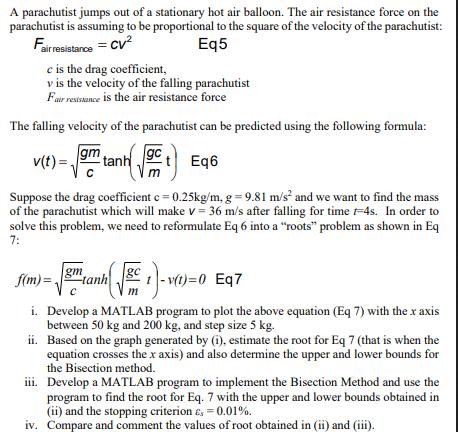Answered step by step
Verified Expert Solution
Question
1 Approved Answer
A parachutist jumps out of a stationary hot air balloon. The air resistance force on the parachutist is assuming to be proportional to the

A parachutist jumps out of a stationary hot air balloon. The air resistance force on the parachutist is assuming to be proportional to the square of the velocity of the parachutist: Fair resistance = CV2 c is the drag coefficient, Eq5 v is the velocity of the falling parachutist Fair resistance is the air resistance force The falling velocity of the parachutist can be predicted using the following formula: v(t)=. gm om tanho Eq6 Suppose the drag coefficient c = 0.25kg/m, g = 9.81 m/s and we want to find the mass of the parachutist which will make v = 36 m/s after falling for time -4s. In order to solve this problem, we need to reformulate Eq 6 into a "roots" problem as shown in Eq 7: f(m)= gm tanh (1) - v(t)=0 Eq7 m i. Develop a MATLAB program to plot the above equation (Eq 7) with the x axis between 50 kg and 200 kg, and step size 5 kg. ii. Based on the graph generated by (i), estimate the root for Eq 7 (that is when the equation crosses the x axis) and also determine the upper and lower bounds for the Bisection method. iii. Develop a MATLAB program to implement the Bisection Method and use the program to find the root for Eq. 7 with the upper and lower bounds obtained in (ii) and the stopping criterion = 0.01%. iv. Compare and comment the values of root obtained in (ii) and (iii).
Step by Step Solution
★★★★★
3.48 Rating (158 Votes )
There are 3 Steps involved in it
Step: 1
ANSWER GIVEN THAT MatLab program clear all clc given equation c025 g981 v36 t...
Get Instant Access to Expert-Tailored Solutions
See step-by-step solutions with expert insights and AI powered tools for academic success
Step: 2

Step: 3

Ace Your Homework with AI
Get the answers you need in no time with our AI-driven, step-by-step assistance
Get Started


